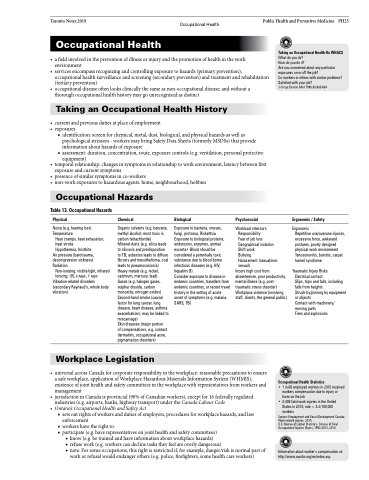Page 1243 - TNFlipTest
P. 1243
Toronto Notes 2019 Occupational Health Public Health and Preventive Medicine PH25 Occupational Health
• afieldinvolvedinthepreventionofillnessorinjuryandthepromotionofhealthinthework environment
• servicesencompassrecognizingandcontrollingexposuretohazards(primaryprevention), occupational health surveillance and screening (secondary prevention) and treatment and rehabilitation (tertiary prevention)
• occupationaldiseaseoftenlooksclinicallythesameasnon-occupationaldisease,andwithouta thorough occupational health history may go unrecognized as distinct
Taking an Occupational Health History
• currentandpreviousdutiesatplaceofemployment
• exposures
■ identification: screen for chemical, metal, dust, biological, and physical hazards as well as psychological stressors - workers may bring Safety Data Sheets (formerly MSDSs) that provide information about hazards of exposure
■ assessment: duration, concentration, route, exposure controls (e.g. ventilation, personal protective equipment)
• temporalrelationship:changesinsymptomsinrelationshiptoworkenvironment,latencybetweenfirst exposure and current symptoms
Taking an Occupational Health Hx WHACS
What do you do?
How do you do it?
Are you concerned about any particular exposures on or off the job?
Co-workers or others with similar problems? Satisfied with your job?
J Occup Environ Med 1998;40:680-684
• presenceofsimilarsymptomsinco-workers
• non-workexposurestohazardousagents:home,neighbourhood,hobbies
Occupational Hazards
Table 13. Occupational Hazards
Physical
Noise (e.g. hearing loss) Temperature
Heat cramps, heat exhaustion, heat stroke
Hypothermia, frostbite
Air pressure (barotrauma, decompression sickness) Radiation
Non-ionizing: visible light, infrared
Ionizing: UV, x-rays, Υ rays Vibration-related disorders (secondary Raynaud’s, whole body vibration)
Chemical
Organic solvents (e.g. benzene, methyl alcohol; most toxic is carbon tetrachloride)
Mineral dusts (e.g. silica leads to silicosis and predisposition to TB, asbestos leads to diffuse fibrosis and mesothelioma, coal leads to pneumoconiosis) Heavy metals (e.g. nickel, cadmium, mercury, lead) Gases (e.g. halogen gases, sulphur dioxide, carbon monoxide, nitrogen oxides) Second-hand smoke (causal factor for lung cancer, lung disease, heart disease, asthma exacerbations; may be linked to miscarriage)
Skin diseases (major portion of compensations, e.g. contact dermatitis, occupational acne, pigmentation disorders)
Biological
Exposure to bacteria, viruses, fungi, protozoa, Rickettsia Exposure to biological proteins, endotoxins, enzymes, animal excreta• Blood should be considered a potentially toxic substance due to blood-borne infectious diseases (e.g. HIV, hepatitis B)
Consider exposure to disease in endemic countries, travellers from endemic countries, or recent travel history in the setting of acute onset of symptoms (e.g. malaria, SARS, TB)
Psychosocial
Workload stressors Responsibility
Fear of job loss Geographical isolation Shift work
Bullying
Harassment (sexual/non- sexual)
Incurs high cost from absenteeism, poor productivity, mental illness (e.g. post- traumatic stress disorder) Workplace violence (involving staff, clients, the general public)
Ergonomic / Safety
Ergonomic
Repetitive use/overuse injuries, excessive force, awkward postures, poorly designed physical work environment Tenosynovitis, bursitis, carpal tunnel syndrome
Traumatic Injury Risks
Electrical contact
Slips, trips and falls, including falls from heights Struck-by/pinning by equipment or objects
Contact with machinery/ moving parts
Fires and explosions
Workplace Legislation
• universalacrossCanadaforcorporateresponsibilityintheworkplace:reasonableprecautionstoensure a safe workplace, application of Workplace Hazardous Materials Information System (WHMIS), existence of joint health and safety committees in the workplace with representatives from workers and management
• jurisdiction in Canada is provincial (90% of Canadian workers), except for 16 federally regulated industries (e.g. airports, banks, highway transport) under the Canada Labour Code
• Ontario’sOccupationalHealthandSafetyAct
■ sets out rights of workers and duties of employers, procedures for workplace hazards, and law
enforcement
■ workers have the right to:
■ participate (e.g. have representatives on joint health and safety committees)
◆ know (e.g. be trained and have information about workplace hazards)
◆ refuse work (e.g. workers can decline tasks they feel are overly dangerous)
◆ note: For some occupations, this right is restricted if, for example, danger/risk is normal part of
work or refusal would endanger others (e.g. police, firefighters, some health care workers)
Occupational Health Statistics
• 1 in 68 employed workers in 2010 received workers compensation due to injury or harm on the job
• 4,405 fatal work injuries in the United States in 2013; rate = 3.2/100,000 workers
Source: Employment and Social Development Canada. Work-related injuries, 2015
U.S. Bureau of Labour Statistics. Census of Fatal Occupational Injuries Charts, 1992-2013, 2014
Information about worker’s compensation at: http://www.awcbc.org/en/index.asp


